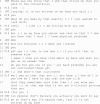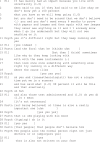It's Not Written All Over My Face: Constructing Chronic Pain as Invisible in Pain Clinic Consultations and Interviews
- PMID: 39782005
- PMCID: PMC11801457
- DOI: 10.1097/AJP.0000000000001273
It's Not Written All Over My Face: Constructing Chronic Pain as Invisible in Pain Clinic Consultations and Interviews
Abstract
Objectives: Historically in medicine and beyond, the understanding of and treatment of pain is based on finding tissue injury. The fact that for chronic pain, there often is no (longer) any traceable tissue injury, in combination with the fact that pain essentially is a private experience, poses a challenge for clinical communication. This paper therefore examines how pain is linguistically and interactionally constructed as invisible.
Materials and methods: The qualitative approach of interactional sociolinguistic analysis is used to analyze 37 consultations and 11 semistructured interviews with patients with chronic pain, collected at a Belgian pain clinic. This fine-grained approach to studying communication provides an in-depth empirical understanding of the phenomenon under scrutiny.
Results: The data show that pain is constructed as invisible on several levels: (1) on the biomechanical and clinical level, in terms of its lack of visible or traceable tissue injury, (2) on the level of interaction, as pain needs to be made apparent to other people through pain displays, and (3) on the social level, as chronic pain often is not visible or apparent in society more broadly.
Conclusion: The discussion explores how on these 3 levels, notions of the abnormal or deviant body come into play, in which patients and health professionals complexly construct pain both as not normal (i.e., not a neutral or desirable state of being), whereas, at the same time, the lack of traceable tissue injury is constructed as medically normal for chronic pain. This also relates to how patients and health care providers often orient to the stigma around chronic pain.
Copyright © 2025 The Author(s). Published by Wolters Kluwer Health, Inc.
Conflict of interest statement
This paper was funded by the Dutch Research Council (NWO) The Hague, The Netherlands, as part of a VENI grant, with grant number VI.Veni.201T.003. The author declares no conflict of interest.
Figures








Similar articles
-
'Treated as a number, not treated as a person': a qualitative exploration of the perceived barriers to effective pain management of patients with chronic pain.BMJ Open. 2017 Jun 12;7(6):e016454. doi: 10.1136/bmjopen-2017-016454. BMJ Open. 2017. PMID: 28606909 Free PMC article.
-
A Comparison of Expectations of Physicians and Patients with Chronic Pain for Pain Clinic Visits.Pain Pract. 2017 Mar;17(3):305-311. doi: 10.1111/papr.12428. Epub 2016 Mar 15. Pain Pract. 2017. PMID: 26992011
-
Duration of opening statement of patients attending a chronic pain clinic consultation.Ir J Med Sci. 2019 Feb;188(1):273-275. doi: 10.1007/s11845-018-1834-x. Epub 2018 May 19. Ir J Med Sci. 2019. PMID: 29779089
-
Communicating about opioids for chronic pain: a qualitative study of patient attributions and the influence of the patient-physician relationship.Eur J Pain. 2014 Jul;18(6):835-43. doi: 10.1002/j.1532-2149.2013.00426.x. Epub 2013 Nov 25. Eur J Pain. 2014. PMID: 24921073
-
'Talk to us like we're people, not an X-ray': the experience of receiving care for chronic pain.Aust J Prim Health. 2013;19(2):138-43. doi: 10.1071/PY11154. Aust J Prim Health. 2013. PMID: 22950973
References
-
- De Ruddere L, Craig KD. Understanding stigma and chronic pain: a-state-of-the-art review. Pain. 2016;157:1607–1610. - PubMed
-
- Goldberg DS. Pain, objectivity and history: understanding pain stigma. Med Humanit. 2017;43:238–243. - PubMed
-
- Krismer M, van Tulder M. Low back pain (non-specific). Best Pract Res Clin Rheumatol. 2007;21:77–91. - PubMed
-
- Flynn TW, Smith B, Chou R. Appropriate use of diagnostic imaging in low back pain: a reminder that unnecessary imaging may do as much harm as good. J Orthop Sports Phys Ther. 2011;41:838–846. - PubMed
-
- Cheatle MD. Biopsychosocial approach to assessing and managing patients with chronic pain. Med Clin NA. 2016;100:43–53. - PubMed
MeSH terms
LinkOut - more resources
Full Text Sources
Medical

